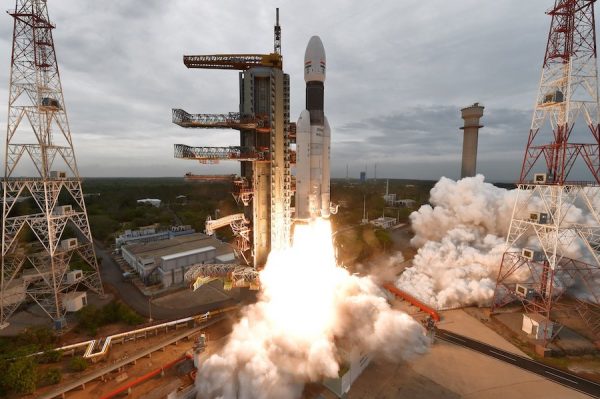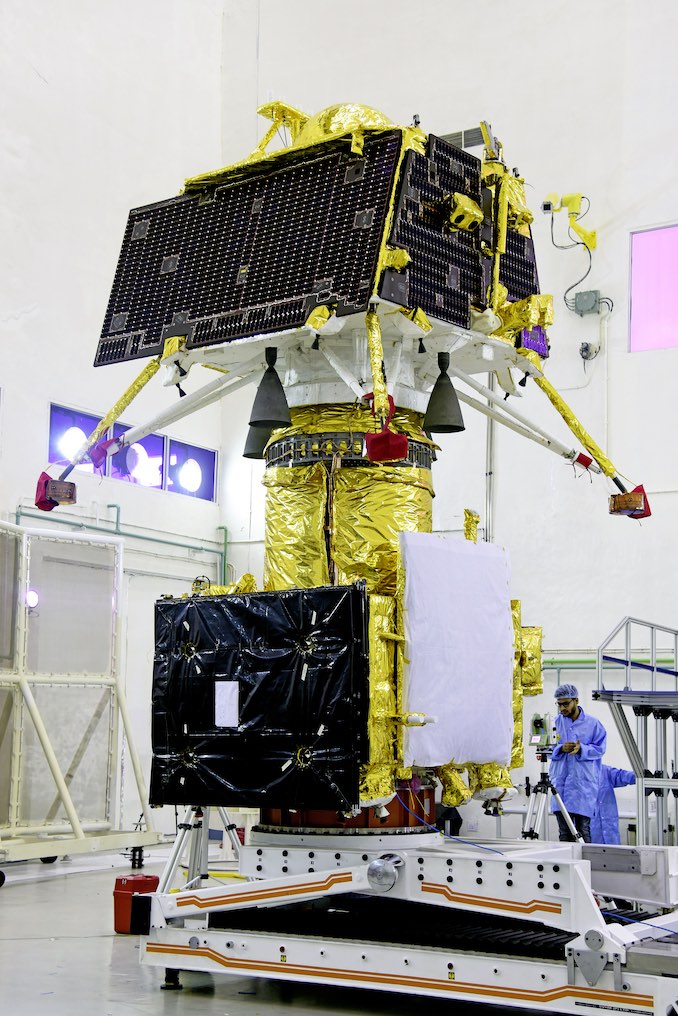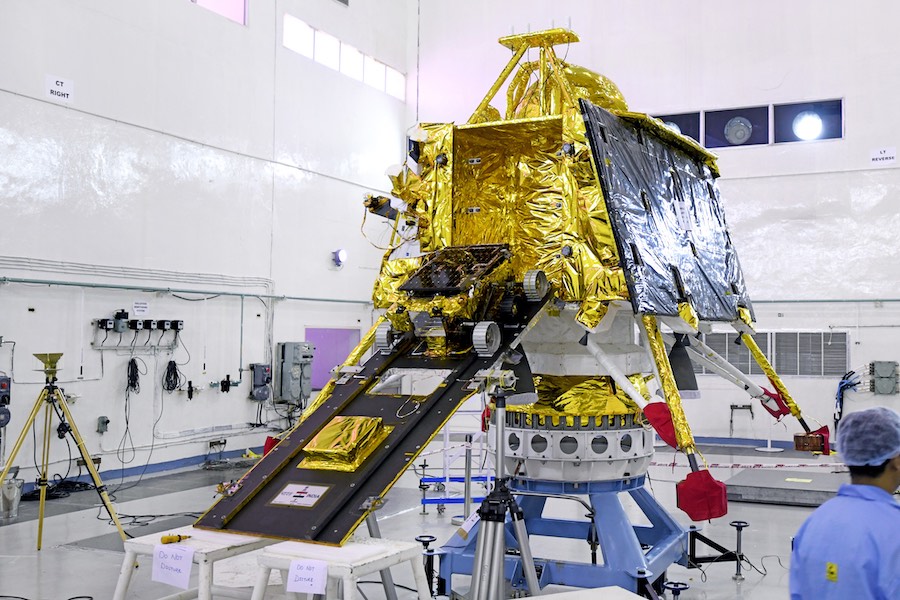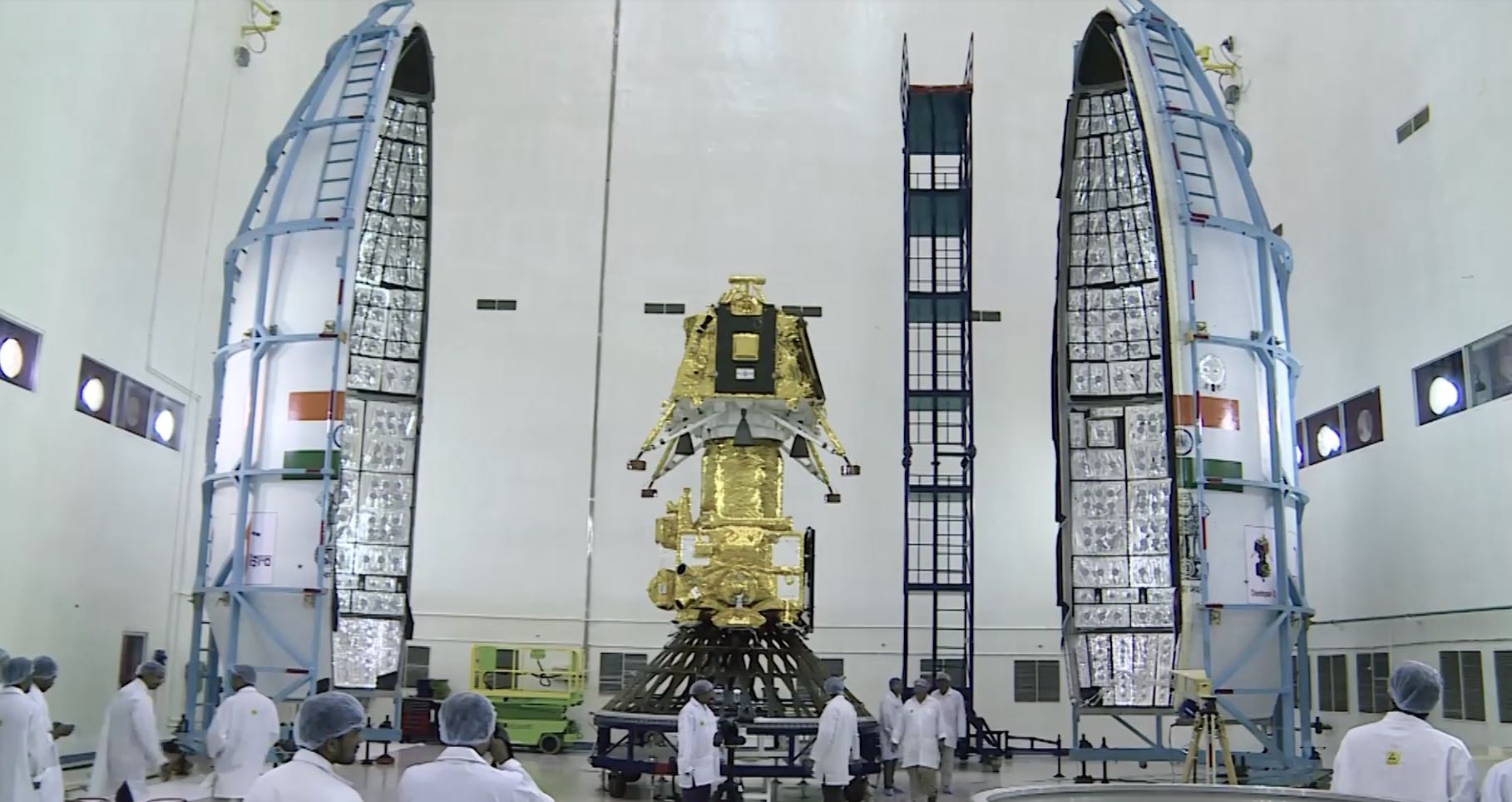India launches robotic mission to land on the moon – Spaceflight Now

Seeking to become the fourth nation to successfully land on the moon, India launched an ambitious robotic lunar mission named Chandrayaan 2 on Monday, targeting a touchdown near the lunar south pole Sept. 6.
Consisting of an orbiter, lander and rover, the Chandrayaan 2 mission is India’s most daring space project to date. Chandrayaan 2 lifted off at 0913 GMT (5:13 a.m. EDT) Monday from the Satish Dhawan Space Center on India’s southeastern coast.
Heading into a cloudy sky and arcing toward east from the launch base over the Bay of Bengal, Chandrayaan 2 rode into space on top of a GSLV Mk.3 rocket, the most powerful launcher in India’s inventory.
The GSLV Mk.3 fired off the pad with 2.2 million pounds of thrust from two side-mounted solid rocket boosters, then ignited a twin-engine liquid-fueled core stage around two minutes after liftoff. After jettisoning the solid-fueled rocket boosters and its nose cone, the GSLV Mk.3’s core stage shut down around five minutes into the mission, followed by ignition of an advanced cryogenic upper stage engine burning super-cold liquid hydrogen and liquid oxygen.
The upper stage fired for about 11 minutes and burned to depletion to propel the Chandrayaan 2 spacecraft into the highest orbit possible. U.S. military tracking data indicated the rocket placed Chandrayaan 2 in an orbit stretching more than 28,000 miles (45,000 kilometers) above Earth, some 3,700 miles (6,000 kilometers) higher than expected.
That is good news for Chandrayaan 2, which will need less fuel to send itself toward the moon through a series of orbit-raising maneuvers planned over the next few weeks, the Indian Space Research Organization said.
Moments after shutdown of the upper stage engine, ISRO’s team at the launch control center confirmed separation of the Chandrayaan 2 spacecraft. A camera aboard the rocket showed the spacecraft flying away from the upper stage, prompting a round of applause in the control center.
“Today is a historical day for space and science and technology in India,” said K. Sivan, ISRO’s chairman, after officials declared the launch a success.
The combined Chandrayaan 2 spacecraft weighed about 8,547 pounds (3,877 kilograms) fully fueled for launch, and the probe measures 19 feet (5.8 meters) long and more than 10 feet (3.1 meters) in diameter.

Sivan said the higher-than-expected orbit achieved by the GSLV Mk.3 launcher will result in “more life and more fuel for flying maneuvers” on Chandrayaan 2’s journey to the moon.
The launch was delayed from last Sunday after the launch team detected a leak on the GSLV Mk.3’s cryogenic upper stage. Workers reportedly tightened a component or connector on the rocket to resolve the problem, and ISRO resumed launch preparations for a second attempt Monday.
“It is the beginning of an historical journey of India to Earth’s moon, and to land at a place near the south pole to carry out scientific experiments to explore another world,” Sivan said. “In fact, after the serious technical snag we had (July 14) — and we fixed that technical snag — now ISRO has bounced back with flying colors.”
Sivan praised the workforce at the launch base for quickly resolving the problem on the rocket’s upper stage.
“(Over) the next 24 hours, the work done in the center was mind-boggling, and quickly the vehicle was brought back to normal and (we) identified the root cause of the technical snag correctly,” Sivan said.
Indian officials adjusted Chandrayaan 2’s flight plan to accommodate the launch delay, while still keeping to a target landing date Sept. 6.
The biggest change to Chandrayaan 2’s flight plan is that the combined spacecraft — comprising the orbiter, lander and rover — will spend less time in lunar orbit before the descent module separates in preparation for landing.
Chandrayaan 2’s own propulsion system will gradually raise its orbit through a series of six rocket firings, before breaking free of the grip of Earth’s gravity with a trans-lunar injection maneuver Aug. 14 to head for the moon. Chandrayaan 2 will fire its main engine again Aug. 20 swing into an elliptical lunar orbit ranging more than 11,000 miles (18,000 kilometers) from the moon.
Instead of spending four weeks together in lunar orbit — as planned if the launch occurred last Sunday — the Chandrayaan 2 spacecraft will lower its altitude over a 13-day period with additional maneuvers, before reaching a circular 62-mile-high (100-kilometer) loop around the moon.
The lander will separate around Sept. 1 to begin descending to the lunar surface.
The landing module is named Vikram for Vikram Sarabhai, the father of India’s space program, and after touchdown will deploy the Pragyan rover, named for the Sanskrit word for “wisdom.”
The Vikram lander will first lower its orbit to fly as close as 100,000 feet (30 kilometers) from the lunar surface. The final 15-minute landing sequence will set up for touchdown in an ancient polar highlands region between two craters at approximately 70.9 degrees south latitude, and 22.8 degrees east longitude, closer to the moon’s south pole than any previous mission.
Landing is scheduled for 2128 GMT (5:28 p.m. EDT) on Sept. 6, according to ISRO.

But Chandrayaan 2 has a long voyage before reaching the landing site.
“Now the mantle is given to the satellite team, our Chandrayaan 2 mission team,” Sivan said after Monday’s launch. “They are going to have to do 15 very crucial maneuvers during the next one-and-a-half months, and finally bring Chandrayaan 2 around the moon.
“After that, the D-Day will come, and on that day we are going to experience 15 minutes of terror to ensure the landing is safe near the south pole,” Sivan continued in remarks to VIPs and top government officials. “My dear friends, our task is not over.”
Five throttleable liquid-fueled engines will control the lander’s rate of descent, and a laser rangefinder will guide the spacecraft toward the landing zone.
Chandrayaan 2’s stationary lander and rover are designed to last 14 days — equivalent to half of a lunar day — until the sun sets at the landing site, robbing the vehicles of electrical power as temperatures plummet to near minus 300 degrees Fahrenheit (minus 183 degrees Celsius).
If the landing is successful, India will become the fourth nation to accomplish a controlled soft touchdown on the moon, following landings by the Soviet Union, the United States and China.
Clive Neal, a lunar scientist at the University of Notre Dame, said India’s space program is “making great strides” after placing spacecraft into orbit around the moon and Mars in 2008 and 2013, respectively.
Chandrayaan 2 is a follow-up to India’s Chandrayaan 1 lunar orbiter, which made history by detecting water-bearing molecules at the moon’s poles, with the highest concentrations inside permanently-shadowed craters at the south pole.
“This proof of capability, the Chandryaaan 2 mission with the lander and the rover, is very ambitious,” Neal said in an interview with Spaceflight Now.
And Chandrayaan 2’s cost of approximately $142 million is a fraction of the development budget for NASA’s Lunar Reconnaissance Orbiter, which cost more than $500 million to build and launch in 2009.
“They’ve got a nice landing site picked out,” Neal said before Chandrayaan 2’s launch. “It looks pretty benign in terms of small craters and boulders. This would be a pathfinder for future landings in more challenging environments, and because it’s a new place (to explore) on the moon, there will be good science that comes out of it.”
China is the most recent country to join the elite group of nations with successful moon landing missions. China’s Chang’e 3 mission landed on the near side of the moon in 2013, and Chang’e 4 made the first soft landing on the far side of the moon in January.
Chang’e 4’s lander and rover are still operating, and if successful, the arrival of Chandrayaan 2 in September could mark the first time since the 1970s that two spacecraft have operated on the moon’s surface at the same time.
“This is very exciting, and I wish them well,” Neal said. “They’ve got a wealth of experiments that they’re carrying on the orbiter, the lander and the rover. It’s going to tell us some interesting things about the lunar surface at a location we haven’t been to.”

ISRO says the orbiter’s mission will last at least a year, taking high-resolution images and scanning the lunar surface with radar and spectral imagers to hunt for signs of water ice.
Officials originally designed the Chandrayaan 2 mission as a joint endeavor with Russia, which was to provide the landing module to fly to the moon with an Indian-made orbiter and rover. But Russia dropped out of the project after the failure of the Phobos-Grunt Mars probe in 2011, prompting the Indian government to make Chandrayaan 2 an all-Indian mission.
“This mission is not only ISRO’s mission,” Sivan said in a press briefing last month. “It is a mission of the entire country.”
The Chandrayaan 2 spacecraft’s three components each carry a suite of scientific instruments:
- Orbiter
- Mass: 5,244 pounds (2,379 kilograms)
- Dimensions: 3.2 x 5.8 x 2.1 meters (10.5 x 19.0 x 6.9 feet)
- Power: 1,000 watts
- Description: The Chandrayaan 2 orbiter — designed for a one-year mission — carries eight scientific instruments, including a high-resolution stereo imaging camera, a dual-frequency synthetic aperture radar look for evidence of water ice at the lunar poles, an imaging infrared spectrometer to aid in the search for water, and sensors to study the moon’s tenuous atmosphere. The orbiter will also provide data relay services the Vikram lander.
- Vikram Lander
- Mass: 3,243 pounds (1,471 kilograms)
- Dimensions: 2.54 x 2.0 x 1.2 meters (8.33 x 6.6 x 3.9 feet)
- Power: 650 watts
- Description: The Vikram lander’s targeted touchdown zone is located in a highland region on the the near side of the moon at approximately 70.9 degrees south latitude, closer to the moon’s south pole than any previous lunar landing mission. Vikram will use five throttleable liquid-fueled engines to slow down for landing. The stationary landing craft carries a suite of multiple cameras and three science instruments, including a seismometer to listen for moonquakes, a thermal probe to reach a depth of up to 33 feet (10 meters) to measure the vertical temperature gradient in the lunar crust, sensors to investigate plasma near the moon’s surface, and a NASA-provided laser retroreflector array to help scientists locate the lander’s exact position on the moon. The Vikram lander is designed to last 14 days on the moon, equivalent to one lunar day.
- Pragyan Rover
- Mass: 59 pounds (27 kilograms)
- Dimensions: 0.9 x 0.75 x 0.85 meters (3.0 x 2.46 x 2.79 feet)
- Power: 50 watts
- Description: The solar-powered Pragyan rover has a range of up to 500 meters, or 1,640 feet, during its 14-day mission on the moon. The AI-enabled rover has six wheels and will relay science data and images through a radio link with the Vikram lander. Indian scientists installed an alpha particle X-ray spectrometer to measure the elemental composition of the rocks at the Chandrayaan 2 landing site, along with a laser-induced breakdown spectroscope. The Pragyan rover is named for the Sanskrit word for “wisdom.”
The lander’s targeted destination is roughly 220 miles (350 kilometers) from the rim of the South Pole-Aitken basin, a region scientists believe is one of the most ancient impact sites in the solar system, created when a large asteroid or comet struck the moon billions of years ago.
For the first time, Chandrayaan 2’s rover could examine ancient material in the lunar crust ejected during the colossal collision that created the South Pole-Aitken basin, providing data that could yield clues about the solar system’s chaotic early history.

China’s Chang’e 4 mission, landed on the far side of the moon in January, is exploring the mid-latitudes of the southern hemisphere, within the South Pole-Aitken basin.
Unlike the Indian Pragyan rover, Chang’e 4 does not carry an alpha X-ray spectrometer, or APXS, to obtain compositional measurements of the lunar crust. The presence of such an instrument on-board Chandrayaan 2 could be boon for lunar geologists.
Neal said he wished Chang’e 4’s rover, named Yutu 2, carried an APXS instrument to the far side of the moon.
The APXS on the Indian rover “will give us an idea of the chemical composition of the rocks that are there,” Neal said. “That is going to be a critical piece of the puzzle … It’s going to tell us more about the composition at that particular vicinity, whether or not it will find water. It doesn’t look like it’s too close to the permanently-shadowed regions, but we don’t know what’s underneath the regolith there.”
Science instrumentation on Chandrayaan 2’s orbiter could provide the most detailed data yet obtained about the amount of water ice hidden inside the moon’s polar craters. The sensors can also detect the presence of hydroxyl molecules, which have oxygen and hydrogen atoms bonded together.
The Indian orbiter’s dual-frequency radar, with L-band and S-band beams, will be sensitive to underground ice deposits up to 16 feet (5 meters) below the lunar surface, twice as deep as reachable by radars carried Chandrayaan 1 and NASA’s Lunar Reconnaissance Orbiter.
“I think on the orbiter — it’s got a year long mission — the radar would be good because although LRO has a radar, it is only in receiving mode, not transmission mode, so we have to transmit from Earth in order to use it right now,” Neal said. “So a lot of locations are not amenable to that.”
Chandrayaan 2 could give scientists more refined maps of the location of water ice deposits, and a more accurate inventory for how much water is trapped inside the permanently-shadowed polar craters.
“That has a lot of potential, as does the infrared spectrometer,” Neal said. “It’ll help show whether or not there’s a hydroxyl or water signal at the surface.”
Such information is critical for future human expeditions to the moon, such as those planned as part of NASA’s Artemis program, which aims to return astronauts to the moon by 2024 under a directive from the Trump administration.
India’s lunar lander may soon be joined on the moon by privately-developed probes and rovers. NASA awarded contracts to three U.S. companies to build robotic landers to carry U.S. science instruments to the moon in 2020 and 2021.
Earlier this year, a privately-funded Israeli spacecraft named Beresheet attempted to land on the moon, but the probe crashed during final descent.
Chandrayaan 2’s launch came two days after the 50th anniversary of the Apollo 11 moon landing.
“I think the international and the commercial interest in the moon is really fantastic, and what it shows us is that the world and private industry have caught up with NASA,” Neal said.
Email the author.
Follow Stephen Clark on Twitter: @StephenClark1.






